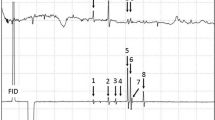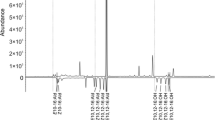Abstract
The response of male cabbage looper (CL) and soybean iooper (SBL) moths was observed in the flight tunnel and measured in field tests to the six-component CL pheromone, the five-component SBL pheromone, and toZ7–12: OAc, the major component common to each pheromone. In both the flight tunnel and the field, male CL exhibited significantly greater levels of response to their six-component blend than toZ7–12: OAc alone. A low level of cross-attraction of male CL to the SBL pheromone was observed in both the flight tunnel and the field, but it was quantitatively and qualitatively similar to their response toZ7–12: OAc alone. Thus the minor components of the SBL blend did not appear to disrupt the flight behavior of male CL. With respect to SBL, in the flight tunnel males also exhibited a greater level of response to the five-component blend compared toZ7–12: OAc, but in the field their response was not significantly different to either treatment. There was also a low level of cross-attraction of male SBL to the CL blend, but this appeared to involve a significant arrestment effect on the upwind flight of males, as well as a difference in male sensitivity to the blend of components compared withZ7–12: OAc alone. The observed arrestment effect may have been due to male perception of one or more minor components of the CL pheromone. The results show that the multicomponent pheromones of these species function effectively as specific mating signals and that discrimination of odor quality by male moths can occur as the result of minor components affecting male sensitivity or their upwind flight response to the pheromone.
Similar content being viewed by others
References
Berger, R.S., 1966, Isolation, identification, and synthesis of the sex attractant of the cabbage looper,Trichoplusia ni.Ann. Entomol. Soc. Am. 59:767–711.
Biostad, L.B., Linn, C.E., Du, J.W., andRoelofs, W.L. 1984. Identification of new sex pheromone components inTrichoplusia ni, predicted from biosynthetic precursors.J. Chem. Ecol. 10:1309–1323.
Cardé, R.T., andBaker, T.C. 1984. Sexual communication with pheromones, pp. 355–383,in W.J. Bell and R.T. Cardé (eds.). Chemical Ecology of Insects. Chapman and Hall, London.
Eichlin, T.D. 1975. Guide to the adult and larval Plusiinae of California.Occas. Pap. Entomol.,State Calif. Dep. Food Agric. No. 21, 73 pp.
Grant, A.J.,O'connell, R.J., andHammond, A.M. 1987. A comparative study of the neurophysiological response characteristics of olfactory receptor neurons in two species of noctuid moths.Ann. N.Y. Acad. Sci. in press.
Leppla, N.C. 1983. Chemically mediated reproductive isolation between cabbage looper and soybean looper moths (Lepidoptera: Noctuidae).Environ. Entomol. 12:1760–1765.
Leppla, N.C., Hamilton, E.W., Guy, R.H., andLee, F.L. 1979. Circadian rhythms of locomotion in six noctuid moth species.Ann. Entomol. Soc. Am. 72:209–215.
Linn, C.E., Jr., Bjostad, L.B., Du, J.W., andRoelofs, W.L. 1984. Redundancy in a chemical signal: Behavioral responses of maleTrichoplusia ni to a six-component sex pheromone blend.J. Chem. Ecol. 10:1635–1658.
Linn, C.E., Jr., Campbell, M.G., andRoelofs, W.L. 1986. Male moth sensitivity to multicomponent pheromones: Critical role of female-released blend in determining the functional role of components and the active space of the pheromone.J. Chem. Ecol. 12:659–668.
Linn, C.E., Jr., Du, J.W., Hammond, A., andRoelofs, W.L. 1987. Identification of unique pheromone components for the soybean looper mothPseudoplusia includens.J. Chem. Ecol. 13:1351–1360.
Miller, J.R., andRoelofs, W.L. 1978. Sustained-flight tunnel for measuring insect responses to wind borne sex pheromones.J. Chem. Ecol. 4:142–149.
Mitchell, E.R. 1972. Female cabbage looper inhibit attraction of male soybean looper.Environ. Entomol. 1:444–446.
Mitchell, E.R. 1973. Nocturnal activity of adults of three species of loopers based on collections in pheromone traps.Environ. Entomol. 2:1078–1080.
Priesner, E. 1980. Sensory encoding of pheromone signals and related stimuli in moths, pp. 359–366,in Insect Neurobiology and Insecticide Action (Neurotox 79), Society of Chemical Industry, London.
Priesner, E. 1985. Inhibitors of sexual attraction in the mothAgrotis exclaimationis.Z. Naturforsch. 40:943–945.
Roelofs, W.L., andBrown, R.L. 1982. Pheromones and evolutionary relationships of Tortricidae.Annu. Rev. Ecol. Syst. 13:395–422.
Ryan, J.A. 1960. Significance tests for multiple comparison of proportions, variances, and other statistics.Psychol. Bull. 57:318–328.
Shorey, H.H., andHale, R.H. 1965. Mass-rearing of the larvae of nine noctuid species on a simple artificial medium.J. Econ. Entomol. 58:522–524.
Steck, W.F., Underhill, E.W., Chisholm, M.D., andGerber, H.S. 1979. Sex attractant for male alfalfa looper moths,Autographa californica.Environ. Entomol. 8:373–375.
Steel, R.G.D., andTorrie, J.H. 1960. Principles and Procedures of Statistics. McGraw-Hill, New York, 481 pp.
Tamaki, Y. 1985. Sex Pheromones, pp. 145–193,in G.A. Kerkut and L.I. Gilbert (eds.) Comprehensive Insect Physiology, Biochemistry, and Pharmacology. Pergamon Press, New York.
Tumlinson, J.H., Mitchell, E.R., Browner, S.M., andLindquist, D.A. 1972. A sex pheromone for the soybean looper.Environ. Entomol. 1:466–468.
Author information
Authors and Affiliations
Rights and permissions
About this article
Cite this article
Linn, C.E., Hammond, A., Du, J. et al. Specificity of male response to multicomponent pheromones in noctuid mothsTrichoplusia ni andPseudoplusia includens . J Chem Ecol 14, 47–57 (1988). https://doi.org/10.1007/BF01022530
Received:
Accepted:
Issue Date:
DOI: https://doi.org/10.1007/BF01022530




